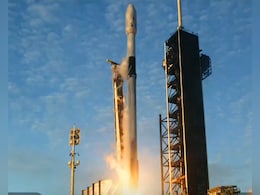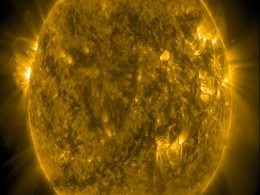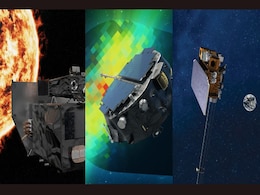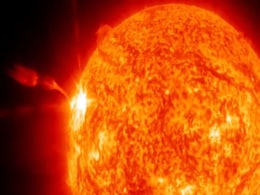Space Storm
- All
- News
- Videos
-

Solar Storm Could Trigger Satellite Collisions In Some Conditions: Study
- Wednesday December 17, 2025
- Science |
A new study warns that a major solar storm could disable satellite controls and trigger cascading collisions in low Earth orbit within about three days.
-
 www.ndtv.com
www.ndtv.com
-

NASA’s Parker Solar Probe Observes Solar Wind Making ‘U-Turn’, Shedding Light on Space Weather
- Wednesday December 17, 2025
NASA’s Parker Solar Probe captured solar wind reversing toward the sun, revealing how magnetic fields recycle coronal material. This process, seen during a close flyby, helps refine models of space weather and may allow scientists to better predict solar storms that can impact satellites, communications, and power systems across the solar system.
-
 www.gadgets360.com
www.gadgets360.com
-

Massive Sunspot Complex on the Sun Raises Risk of Strong Solar Storms
- Tuesday December 9, 2025
A massive sunspot complex has appeared on the Sun, covering an area comparable to the legendary Carrington Event region. Known as AR 4294-96, the active cluster features highly tangled magnetic fields that could unleash powerful solar flares and geomagnetic storms, potentially disrupting satellites, power grids, and global communications if Earth-d...
-
 www.gadgets360.com
www.gadgets360.com
-

Strongest Solar Flare of 2025 Sends High-Energy Radiation Rushing Toward Earth
- Saturday December 6, 2025
A powerful X5.1 solar flare on November 11, 2025, sent high-speed protons toward Earth, producing the strongest radiation spike detected in nearly two decades. The event caused a rare ground-level enhancement, briefly raising radiation at flight altitude to ten times normal. While not dangerous this time, scientists warn larger flares could threate...
-
 www.gadgets360.com
www.gadgets360.com
-

NASA’s Perseverance Records First-Ever Mini-Lightning on Mars
- Tuesday December 2, 2025
NASA’s Perseverance rover has captured the first confirmed mini-lightning sparks in Mars’ dusty atmosphere. Using its sensitive microphone, the rover recorded 55 tiny electrical discharges during dust storms over two Martian years. These sparks generate reactive chemicals that can break down organic molecules, affecting future life-detection ef...
-
 www.gadgets360.com
www.gadgets360.com
-

Viral Video Takes Us Inside Sleeping Pods At Bengaluru Airport, Leaves Internet Divided
- Saturday November 22, 2025
- Travel |
A viral reel showing what the sleeping pods at Bengaluru airport are like from the inside has taken social media by storm and received mixed reactions.
-
 www.ndtv.com/travel
www.ndtv.com/travel
-

Intense Solar Storm With Huge CMEs Forced Astronauts to Take Shelter on the ISS
- Sunday November 16, 2025
A major solar storm in mid-November 2025 dazzled Earth with vivid auroras but forced astronauts on the ISS to take radiation precautions. Russian cosmonauts sheltered in the station’s heavily protected Destiny lab, while other crew members stayed in shielded quarters as controllers limited access to higher-risk modules during the event.
-
 www.gadgets360.com
www.gadgets360.com
-

Sun Unleashes Strongest Flare of 2025, Causing Global Radio Blackouts
- Thursday November 13, 2025
On Nov. 11, 2025, the Sun erupted with an X5.1-class flare, disrupting shortwave communications across Africa and Europe. The flare’s X-rays and UV radiation ionized Earth’s upper atmosphere, causing R3-level radio blackouts. NOAA warned that a coronal mass ejection could reach Earth on Nov. 12, potentially triggering strong geomagnetic storms ...
-
 www.gadgets360.com
www.gadgets360.com
-

Hubble Observes Massive Stellar Eruption from EK Draconis, Hinting at Life’s Origins
- Sunday November 2, 2025
Astronomers using the Hubble Space Telescope observed a huge solar storm from EK Draconis, a young Sun-like star. The eruption’s energy may trigger atmospheric chemistry, forming greenhouse gases and organic molecules. Such events could mirror early solar activity that helped spark life on ancient Earth and distant exoplanets.
-
 www.gadgets360.com
www.gadgets360.com
-

Northern Lights Could Be Visible in These US States Tonight, How To See Them
- Wednesday October 29, 2025
- Science |
The northern lights are caused by geomagnetic storms, which occur when charged particles from the sun collide with gases in Earth's atmosphere, creating brilliant waves of light in the sky.
-
 www.ndtv.com
www.ndtv.com
-

SpaceX Launches IMAP, CGO, SWFO-L1 to Probe Solar Frontier and Space Weather
- Sunday September 28, 2025
A Falcon 9 lifted off from Kennedy Space Center on Sept. 24, 2025, carrying NASA’s IMAP, CGO, and SWFO-L1 spacecraft. The mission aims to chart the heliosphere’s boundary, monitor Earth’s geocorona, and deliver constant space-weather alerts, protecting satellites and astronauts while expanding knowledge of the solar system’s outer edge.
-
 www.gadgets360.com
www.gadgets360.com
-

Solar Storm From Hidden Magnetic Island on the Sun Surprises Scientists
- Wednesday September 17, 2025
In mid-September 2025, a “secret” magnetic island inside a solar coronal hole triggered a powerful G3 storm. The surprise event sent dazzling auroras across North America, seen as far south as Illinois. Researchers say the rare polarity patch intensified solar winds, making aurora season’s start spectacular.
-
 www.gadgets360.com
www.gadgets360.com
-

Sun Shows Signs of Rising Activity Following Decades of Weakening, Study Finds
- Thursday September 18, 2025
A new NASA study shows the Sun’s activity has been rising since 2008, reversing decades of decline. The unexpected trend suggests greater risks from solar storms, flares, and plasma ejections. Scientists stress improved forecasting is essential, with upcoming missions like IMAP and SWFO-L1 set to expand space weather monitoring and protection eff...
-
 www.gadgets360.com
www.gadgets360.com
-

IMAP Space Weather Mission to Lift Off Soon, NASA Confirms Broadcast Plans
- Thursday September 18, 2025
NASA will stream the Sept. 23 launch of IMAP with two rideshare satellites from Kennedy Space Centre. IMAP will study the heliosphere, Carruthers will image Earth’s exosphere, and NOAA’s SWFO-L1 will provide early solar storm warnings. Together, the missions advance space weather science while protecting satellites, communications, and power sy...
-
 www.gadgets360.com
www.gadgets360.com
-

Scientists Say Solar Flares Are Hotter Than Expected, Could Reach 108 Million Degrees
- Friday September 12, 2025
A groundbreaking study shows ions in solar flares can reach 108 million°F, about six times hotter than earlier estimates. The research explains decades-old mysteries in flare spectra and urges new “multi-temperature” models to better forecast space weather, protecting satellites, astronauts, and communications from hazardous solar storms.
-
 www.gadgets360.com
www.gadgets360.com
-

Solar Storm Could Trigger Satellite Collisions In Some Conditions: Study
- Wednesday December 17, 2025
- Science |
A new study warns that a major solar storm could disable satellite controls and trigger cascading collisions in low Earth orbit within about three days.
-
 www.ndtv.com
www.ndtv.com
-

NASA’s Parker Solar Probe Observes Solar Wind Making ‘U-Turn’, Shedding Light on Space Weather
- Wednesday December 17, 2025
NASA’s Parker Solar Probe captured solar wind reversing toward the sun, revealing how magnetic fields recycle coronal material. This process, seen during a close flyby, helps refine models of space weather and may allow scientists to better predict solar storms that can impact satellites, communications, and power systems across the solar system.
-
 www.gadgets360.com
www.gadgets360.com
-

Massive Sunspot Complex on the Sun Raises Risk of Strong Solar Storms
- Tuesday December 9, 2025
A massive sunspot complex has appeared on the Sun, covering an area comparable to the legendary Carrington Event region. Known as AR 4294-96, the active cluster features highly tangled magnetic fields that could unleash powerful solar flares and geomagnetic storms, potentially disrupting satellites, power grids, and global communications if Earth-d...
-
 www.gadgets360.com
www.gadgets360.com
-

Strongest Solar Flare of 2025 Sends High-Energy Radiation Rushing Toward Earth
- Saturday December 6, 2025
A powerful X5.1 solar flare on November 11, 2025, sent high-speed protons toward Earth, producing the strongest radiation spike detected in nearly two decades. The event caused a rare ground-level enhancement, briefly raising radiation at flight altitude to ten times normal. While not dangerous this time, scientists warn larger flares could threate...
-
 www.gadgets360.com
www.gadgets360.com
-

NASA’s Perseverance Records First-Ever Mini-Lightning on Mars
- Tuesday December 2, 2025
NASA’s Perseverance rover has captured the first confirmed mini-lightning sparks in Mars’ dusty atmosphere. Using its sensitive microphone, the rover recorded 55 tiny electrical discharges during dust storms over two Martian years. These sparks generate reactive chemicals that can break down organic molecules, affecting future life-detection ef...
-
 www.gadgets360.com
www.gadgets360.com
-

Viral Video Takes Us Inside Sleeping Pods At Bengaluru Airport, Leaves Internet Divided
- Saturday November 22, 2025
- Travel |
A viral reel showing what the sleeping pods at Bengaluru airport are like from the inside has taken social media by storm and received mixed reactions.
-
 www.ndtv.com/travel
www.ndtv.com/travel
-

Intense Solar Storm With Huge CMEs Forced Astronauts to Take Shelter on the ISS
- Sunday November 16, 2025
A major solar storm in mid-November 2025 dazzled Earth with vivid auroras but forced astronauts on the ISS to take radiation precautions. Russian cosmonauts sheltered in the station’s heavily protected Destiny lab, while other crew members stayed in shielded quarters as controllers limited access to higher-risk modules during the event.
-
 www.gadgets360.com
www.gadgets360.com
-

Sun Unleashes Strongest Flare of 2025, Causing Global Radio Blackouts
- Thursday November 13, 2025
On Nov. 11, 2025, the Sun erupted with an X5.1-class flare, disrupting shortwave communications across Africa and Europe. The flare’s X-rays and UV radiation ionized Earth’s upper atmosphere, causing R3-level radio blackouts. NOAA warned that a coronal mass ejection could reach Earth on Nov. 12, potentially triggering strong geomagnetic storms ...
-
 www.gadgets360.com
www.gadgets360.com
-

Hubble Observes Massive Stellar Eruption from EK Draconis, Hinting at Life’s Origins
- Sunday November 2, 2025
Astronomers using the Hubble Space Telescope observed a huge solar storm from EK Draconis, a young Sun-like star. The eruption’s energy may trigger atmospheric chemistry, forming greenhouse gases and organic molecules. Such events could mirror early solar activity that helped spark life on ancient Earth and distant exoplanets.
-
 www.gadgets360.com
www.gadgets360.com
-

Northern Lights Could Be Visible in These US States Tonight, How To See Them
- Wednesday October 29, 2025
- Science |
The northern lights are caused by geomagnetic storms, which occur when charged particles from the sun collide with gases in Earth's atmosphere, creating brilliant waves of light in the sky.
-
 www.ndtv.com
www.ndtv.com
-

SpaceX Launches IMAP, CGO, SWFO-L1 to Probe Solar Frontier and Space Weather
- Sunday September 28, 2025
A Falcon 9 lifted off from Kennedy Space Center on Sept. 24, 2025, carrying NASA’s IMAP, CGO, and SWFO-L1 spacecraft. The mission aims to chart the heliosphere’s boundary, monitor Earth’s geocorona, and deliver constant space-weather alerts, protecting satellites and astronauts while expanding knowledge of the solar system’s outer edge.
-
 www.gadgets360.com
www.gadgets360.com
-

Solar Storm From Hidden Magnetic Island on the Sun Surprises Scientists
- Wednesday September 17, 2025
In mid-September 2025, a “secret” magnetic island inside a solar coronal hole triggered a powerful G3 storm. The surprise event sent dazzling auroras across North America, seen as far south as Illinois. Researchers say the rare polarity patch intensified solar winds, making aurora season’s start spectacular.
-
 www.gadgets360.com
www.gadgets360.com
-

Sun Shows Signs of Rising Activity Following Decades of Weakening, Study Finds
- Thursday September 18, 2025
A new NASA study shows the Sun’s activity has been rising since 2008, reversing decades of decline. The unexpected trend suggests greater risks from solar storms, flares, and plasma ejections. Scientists stress improved forecasting is essential, with upcoming missions like IMAP and SWFO-L1 set to expand space weather monitoring and protection eff...
-
 www.gadgets360.com
www.gadgets360.com
-

IMAP Space Weather Mission to Lift Off Soon, NASA Confirms Broadcast Plans
- Thursday September 18, 2025
NASA will stream the Sept. 23 launch of IMAP with two rideshare satellites from Kennedy Space Centre. IMAP will study the heliosphere, Carruthers will image Earth’s exosphere, and NOAA’s SWFO-L1 will provide early solar storm warnings. Together, the missions advance space weather science while protecting satellites, communications, and power sy...
-
 www.gadgets360.com
www.gadgets360.com
-

Scientists Say Solar Flares Are Hotter Than Expected, Could Reach 108 Million Degrees
- Friday September 12, 2025
A groundbreaking study shows ions in solar flares can reach 108 million°F, about six times hotter than earlier estimates. The research explains decades-old mysteries in flare spectra and urges new “multi-temperature” models to better forecast space weather, protecting satellites, astronauts, and communications from hazardous solar storms.
-
 www.gadgets360.com
www.gadgets360.com

























